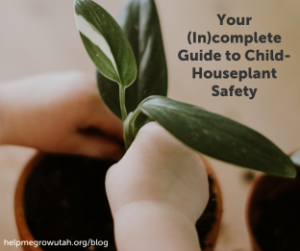 Some of my very favorite things in the Help Me Grow office space are the houseplants we keep. The idea of these little living things brightening our space and continuing to grow, endure, and thrive day by day makes me smile, and I appreciate them all the more for the small favors they ask of me (mainly that I help make sure they get watered).
Some of my very favorite things in the Help Me Grow office space are the houseplants we keep. The idea of these little living things brightening our space and continuing to grow, endure, and thrive day by day makes me smile, and I appreciate them all the more for the small favors they ask of me (mainly that I help make sure they get watered).
While I would never describe myself as a plant expert, there is something about helping these houseplants to thrive that soothes and brings added joy to our workplace, and I think that’s something many people would like to enjoy. Maybe you have always wanted to be a plant mom, but being a parent of actual tiny humans adds an extra level of concern where safety or practicality is involved. This blog post aims to soothe those concerns by talking about the benefits of introducing your children to plants, some of the safety concerns to be aware of, and some nontoxic plant ideas to get you started.
First, why would you want to introduce your children to plants (or plants to your home) in the first place?
As you might have noticed from my experience with our office plants, there are several benefits of keeping indoor houseplants, and there have been many studies completed that document those benefits. These benefits include stress reduction, sharpened attention, quicker recovery from illnesses, and more. One of the more widely-spoken of benefits is air purification. While there has recently been some debate as to the effectiveness of plants’ air purification abilities outside of lab conditions, it’s still safe to say that plants can purify air; it just might not be super noticeable on a household scale.
Aside from the general health benefits that come from keeping indoor plants, there are also reasons why you might specifically want your children to know and love working with plants. For example, working with plants can boost your child’s development across a variety of domains. This can be especially true when you foster their curiosity by discussing questions about how the plant is growing, the science behind how plants work, and measuring plants’ growth. Taking care of plants can also be a good way to help teach your child about responsibility, the joy of nurturing, and many other lessons. You can also have some fun, plant-specific learning with your children as they get older and you start to feel more comfortable introducing them to different types of plants that your children may not have been mature enough to be around before. (Just remember: always, always, always do your own research before introducing your child to a new plant. There are often different sites that will give conflicting information about the toxicity of certain plants, so be prepared by looking up the plant names on their own.)
While the benefits of indoor houseplants are wide and well documented, keeping houseplants also comes with some inherent dangers for children. It may not be possible to come up with a comprehensive list, but here are some of the things you’ll need to be cautious about when introducing plants to your home:
- Starting with the obvious, some plants are toxic to children! (See here, here, or here for some common plants to avoid.) Even if a plant is nontoxic for humans, it might still be toxic for animals (see one example on the list here), so be careful when researching your plants that you are finding something safe for everyone in your family.
- Kids put things in their mouths; it’s part of how they learn. You can expect them to not only be drawn to the plants you bring in, but that they might also try to eat the dirt. You can be prepared for this possibility by either making sure you know what’s in the dirt (and replacing it with organic dirt if need be) or by placing your plants far out of reach of grabbing hands. This can be tricky as children get older and are suddenly able to reach new locations, but hanging baskets can help solve that problem as long as you are aware of hanging vines.
- Speaking of grabbing hands, make sure the plant is in a child-friendly plant pot. In this case, child-friendly means that it’s heavy enough and shaped in such a way to make it difficult for children to move or knock down. What we’re going for here is something really sturdy – planters with a wider base are especially helpful for this. You can also be prepared by keeping the plants high enough to be completely out of reach, as mentioned above.
- Also be aware of possible choking hazards posed by the plants in your home. Even if a plant is non-toxic, it doesn’t mean it’s completely safe for little mouths. Again, placing your plants out of reach can help with that.
- Even beyond toxicity and choking hazards, there are other ways plants can harm your children or be a nuisance in your home. For instance, if you’re bringing a cactus into your home, there is every possibility that the spines would be painful for your child if he or she touches them. Be mindful of potential hazards that your plants might bring. Whether it’s harm to your child or an especially messy plant that sheds, it’s good to be aware.
- There are some other potential health considerations to be aware of when bringing plants into your home. For example, if you’re not careful, houseplants are a sneaky way for certain pests to make their way into the house. Additionally, mold from poorly draining houseplants can affect asthma symptoms. (Learn more here.)
Now, the purpose of this blog post is not to scare you away from houseplants. Rather, the hope is that the more you know, the better prepared you will be to tackle the challenges that houseplants present, especially with little ones involved. That said, there is absolutely no shame in turning to faux plants instead! While they do not come with all of the added benefits of real plants, faux plants can still brighten up a room and improve moods, without many of the dangers that real plants can present. (Although you will still want to be mindful of potential choking hazards or pots that can be easily pulled over. These hazards apply to faux plants as well as real plants.)
If adding plants to your home is something you want to do, there are definitely some plants that will be easier to introduce than others. You can find nontoxic plant ideas across the internet (for example, here, here, here, here, here, or here), but I said it above and I’ll say it again: always, always, always do your own research. Remember that even nontoxic plants are not meant to be ingested, and they can often lead to stomach irritation or have other uncomfortable effects.
That said, here are some plant ideas to get you started (most found on more than one of the sites listed above):
- Spider plant (Chlorophytum Comosum)
- Prayer plant (Maranta Leuconeura)
- Baby rubber plant (Peperomia Obtusifolia)
- Boston fern (Nephrolepis Exaltata)
- Baby’s tears (Soleirolia Soleirolii)
- Nerve plant or Mosaic plant (Fittonia Albivenis)
- African violet (Saintpaulia)
- Christmas cactus (Schlumbergera)
- Ponytail palm (Beaucarnea Recurvata)
- Parlor palm (Chamaedorea Elegans)
- Areca palm (Dypsis Lutescens)
You might have noticed this post’s title, “Your (In)complete Guide to Child-Houseplant Safety.” As thorough as we try to be, there are going to be situations that come up that we might not be completely prepared for. Start teaching your kids plant safety when they are young, and remember that just because a plant is nontoxic does not mean that it is meant to be consumed. Be prepared with the phone number for poison control if necessary, and the scientific names of the plants you have. Also consider where you are placing the plants and how easy it is for children to reach them – for example, any plant on a high shelf where children cannot reach is likely to be safer than even a nontoxic plant in an easy-to-reach place.
There are some amazing benefits that can come from having houseplants and introducing your children to plants when they are young. With a little research and preparation, you can enjoy the benefits of indoor houseplants and add “plant mom” to your parenthood titles, while still keeping your family safe.





